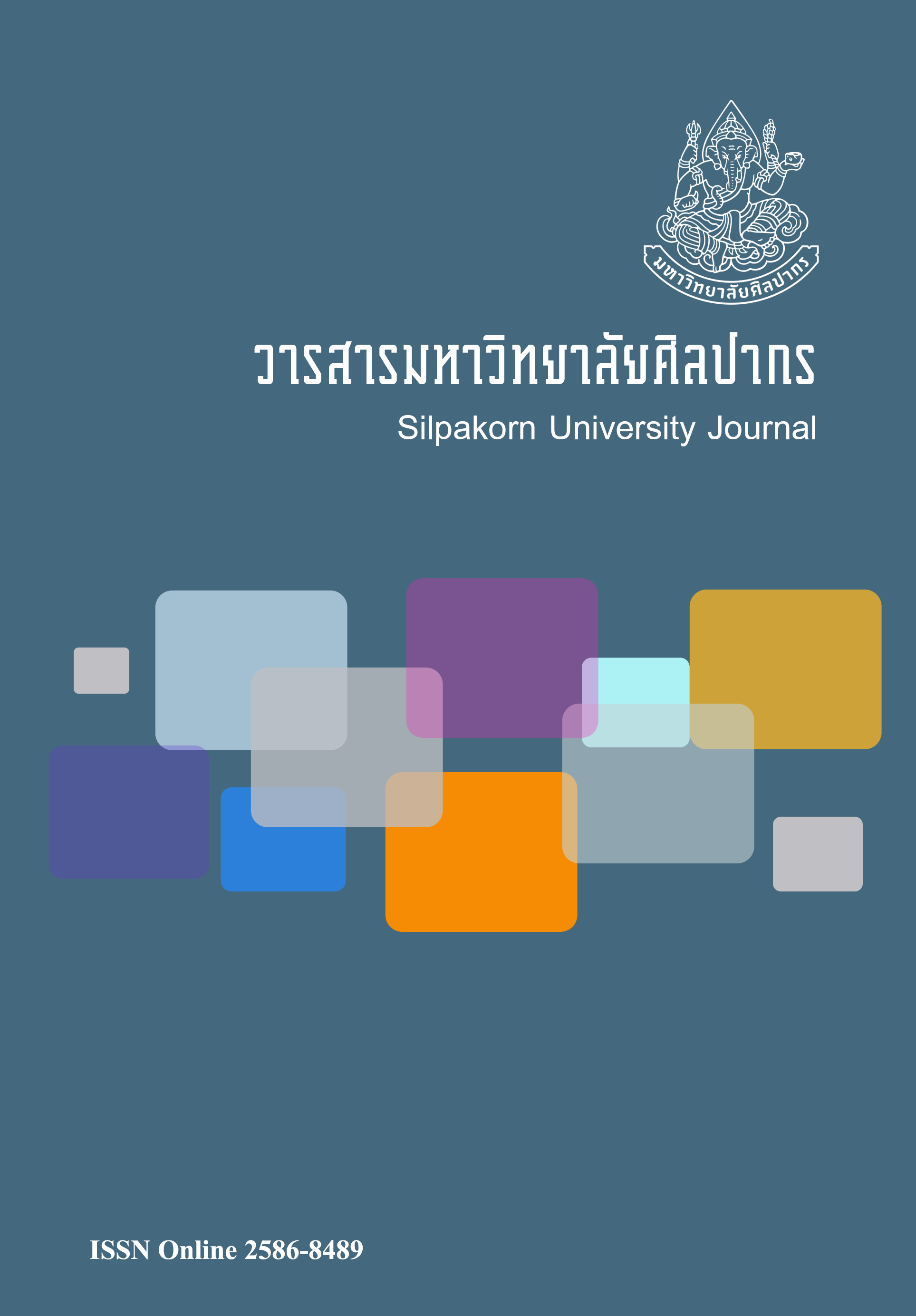พัฒนาการและเงื่อนไขของการรวมกลุ่มเป็นเครือข่ายชุมชนตำบลสะเอียบ อำเภอสอง จังหวัดแพร่ (Development and conditions of integration into a community network in Sa-eab sub-district, Song district, Phrae province)
Main Article Content
Abstract
การวิจัยนี้มีวัตถุประสงค์เพื่อศึกษาพัฒนาการและเงื่อนไขของการรวมกลุ่มเป็นเครือข่ายชุมชนตำบลสะเอียบ อำเภอสอง จังหวัดแพร่ โดยการวิจัยชิ้นนี้เป็นการวิจัยเชิงคุณภาพ ใช้วิธีดำเนินการวิจัยด้วยการศึกษาเอกสาร, การสังเกตการณ์แบบไม่มีส่วนร่วมและการสัมภาษณ์เชิงลึกจากผู้ให้ข้อมูลที่คัดเลือกมาโดยวิธีการสุ่มแบบบอกต่อ (Snowball Sampling) จำนวน 22 คน
ผลการวิจัยพบว่า พัฒนาการของเครือข่ายชุมชนตำบลสะเอียบสามารถพิจารณาได้ห้ายุค ได้แก่ ยุคที่หนึ่ง สภาวะนิ่งเฉยของชุมชน ยุคที่สอง การเข้ามาของ NGO กับการก่อตัวของเครือข่ายชุมชน ยุคที่สาม การขยายตัวของเครือข่ายกับการเกิดขึ้นขององค์กรชุมชน ยุคที่สี่ การเคลื่อนไหวทางสังคมที่ต่อเนื่องของเครือข่ายชุมชน และยุคที่ห้า สู่การเป็นเครือข่ายการเรียนรู้ ซึ่งสถานภาพความเป็นเครือข่ายชุมชนเริ่มเกิดขึ้นในยุคที่สอง ในขณะที่เงื่อนไขของการรวมกลุ่มเป็นเครือข่ายชุมชนตำบลสะเอียบสามารถอธิบายได้ 2 เงื่อนไข ได้แก่ (1) เกิดขึ้นจากการสนับสนุนของหน่วยงานภายนอกและ (2) เกิดขึ้นจากสถานการณ์เป็นตัวกำหนด อย่างไรก็ตาม พัฒนาการของเครือข่ายชุมชนตำบลสะเอียบได้สะท้อนให้เห็นถึงสภาวะการพึ่งพาอาศัยและการแลกเปลี่ยนทรัพยากรระหว่างสมาชิกของเครือข่ายที่ก่อให้เกิดองค์ความรู้ ในขณะเดียวกันยังสะท้อนความเป็นพลวัตของเครือข่ายชุมชนที่มีการปรับตัวไปตามระยะเวลาและเปลี่ยนแปลงไปตามบริบททางสังคมและการเมือง
The objective of this research was to study the development and conditions of integration into the community network in Sa-eab Sub-district, Song District, Phrae Province. This study was a qualitative research project. The research methodology involved studying the documents, non-participatory observations and in-depth interviews with 22 key informants, who were selected using Snowball Sampling.
The results of this study indicated that the development of community network in Sa-eab sub-district can be divided into 5 eras: (1) the standstill of the community, (2) The arrival of the NGO with the formation of community network, (3) the expansion of community network and the emergence of community organizations, (4) the continuous social movements of the community network, and (5) movement toward becoming a learning network. The status of the community network started in the second era. The conditions of integration into the community network in Sa-eab Sub-district can be explained by two conditions: (1) happening by the support of external agencies, (2) happening due to the influence of situation. However, the development of community network in Sa-eab Sub-district shows the interdependency and exchange of resources between members of the network that leads to knowledge. At the same time, it also shows the dynamism of the community network which adapts through time and change in accordance with social and political context.
Downloads
Article Details
References
Jantavises, N. (2000). A study of networking in participatory resources management: a case study of Kookhud community Songkla Lake Basin (การศึกษาเครือข่ายในการจัดการทรัพยากรแบบมีส่วนร่วม กรณีศึกษา : ชุมชนคูขุด ทะเลสาบสงขลา). Master’s dissertation, Mahidol University, Nakhon Pathom, Thailand.
Kahaban, T. (2012). Social network and process driven of health public policy on tumbon level (เครือข่ายทางสังคมกับการขับเคลื่อนกระบวนการนโยบายสาธารณะเพื่อสุขภาพระดับตำบล). Master’s dissertation, Khon Kaen University, Khon Kaen, Thailand.
Keawmongkol, S. (2011). Community ways and local resource management: a case study of Sa-Aib subdistrict community, Song district, Phrae province (วิถีชุมชนกับการจัดการทรัพยากรในท้องถิ่น : ศึกษากรณีชุมชนตำบลสะเอียบ อำเภอสอง จังหวัดแพร่). Master’s dissertation, Ramkhamhaeng University, Bangkok, Thailand.
Kwanyen, P. (2015, January 22). Interview by W. Charoensin [Tape recording]. Master’s dissertation, Chiang Mai University, Chiang Mai, Thailand.
Living River Siam Association. (2012). Kaeng Sua Ten Dam’s 23 years on fight of Sa-eab’s people (เขื่อนแก่งเสือเต้น 23 ปี แห่งการต่อสู้ของชาวสะเอียบ) [Online]. Retrieved January 12, 2015 from https://www.livingriversiam.org/3river-thai/kst/kstd_a23.pdf
Maungrong, S. (2015, September 13). Interview by W. Charoensin [Tape recording]. Master’s dissertation, Chiang Mai University, Chiang Mai, Thailand.
Maungrong, S. (2015, November 30). Interview by W. Charoensin [Tape recording]. Master’s dissertation, Chiang Mai University, Chiang Mai, Thailand.
Nimpanich, J. (2007). Qualitative research in political science and public administration (การวิจัยเชิงคุณภาพในทางรัฐศาสตร์และรัฐประศาสนศาสตร์). Bangkok: Active Print.
Phongphit, S. (2009). Local development strategy (ยุทธศาสตร์พัฒนาท้องถิ่น) (2nd ed.). Bangkok: Palangpanya Publishing.
Phramaha Suthit Aphakaro. (2004). Network: natural, knowledge and management (เครือข่าย : ธรรมชาติ ความรู้ และการจัดการ). Bangkok: Thailand Research Fund.
Poosuwan, B. (Ed.). (2012). Keang Sua Ten Dam: the strength of Sa-eab community, 23 years of fight and power from generation to generation (เขื่อนแก่งเสือเต้น : ความเข้มแข็งชุมชนสะเอียบ 23 ปี การต่อสู้ พลังจากรุ่นสู่รุ่น) [Online]. Retrieved August 18, 2015 from https://thaipublica.org/2012/12/kaeng-sua-ten-dam
Songsiri, W. (2016). Sa-eab’s people and Kaeng Sua Ten Dam project
(ชาวสะเอียบและโครงการแก่งเสือเต้น) [Online]. Retrieved May 30, 2016 from https://lek-prapai.org/home/view.php?id=826
Sretthachau, C. (2000). Political ecology of large dam scheme in Thailand: a case study of Kaeng Sua Ten Dam project (นิเวศวิทยาการเมืองของการสร้างเขื่อนขนาดใหญ่ในประเทศไทย : กรณีศึกษาโครงการเขื่อน
แก่งเสือเต้น). Master’s dissertation, Chiang Mai University, Chiang Mai, Thailand.
Sretthachau, C. (Ed.). (2000). Disastrous-conflict: behind the water diversion project and large dams in the northern and proposed policy (หายนะ-ความขัดแย้ง : เบื้องหลังโครงการผันน้ำและเขื่อนขนาดใหญ่ภาคเหนือและข้อเสนอเชิงนโยบาย). Chiang Mai: South East Asia Rivers Network.
Sujinno, N. (2015, September 13). Interview by W. Charoensin [Tape recording]. Master’s dissertation, Chiang Mai University, Chiang Mai, Thailand.
Sungkaew, B. & Puang-ngam, K. (2015). The developmental dynamics of decentralized decision-making for local actors in the define large scale dam project: case study of Kaeng Sua Ten Dam project (พลวัตการพัฒนาการกระจายอำนาจตัดสินใจสำหรับตัวแสดงท้องถิ่นในกระบวนการกำหนดโครงการเขื่อนขนาดใหญ่ : ศึกษากรณีโครงการเขื่อนแก่งเสือเต้น). SDU Research Journal Humanities and Social Sciences, 11(1), 113-126.
Udom, S. (2015, July 30). Interview by W. Charoensin [Tape recording]. Master’s dissertation, Chiang Mai University, Chiang Mai, Thailand.
Walliphodom, S. & Songsiri, W. (2008). Phrae city from past to present (นครแพร่ จากอดีตมาปัจจุบัน). Bangkok: The Thailand Research Fund.
Wonganutrohd, P. (2001). Social network processes and development: a case study of Ban Nongkhao, Tamueng district, Kanchanaburi (กระบวนการสร้างและพัฒนาเครือข่ายทางสังคม : กรณีศึกษา บ้านหนองขาว อำเภอท่าม่วง จังหวัดกาญจนบุรี). Master’s dissertation, Mahidol University, Nakhon Pathom, Thailand.
Yawichai, T. (2006). Development of watershed management network in natural resources management: a case study of Mae Suk Watershed, Mae Chaem District, Chiang Mai Province (พัฒนาการของเครือข่ายจัดการลุ่มน้ำแม่ศึกในการจัดการทรัพยากรธรรมชาติ : กรณีศึกษาลุ่มน้ำแม่ศึก อำเภอแม่แจ่ม จังหวัดเชียงใหม่). Master’s dissertation, Chiang Mai University, Chiang Mai, Thailand.


